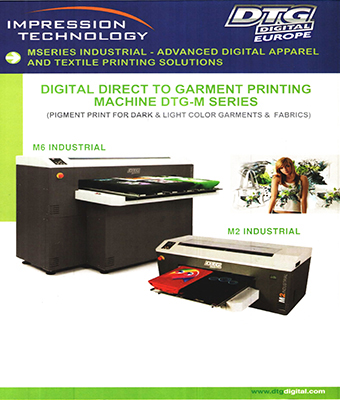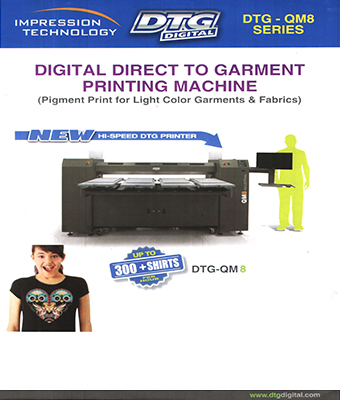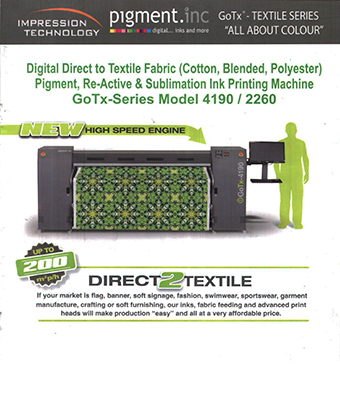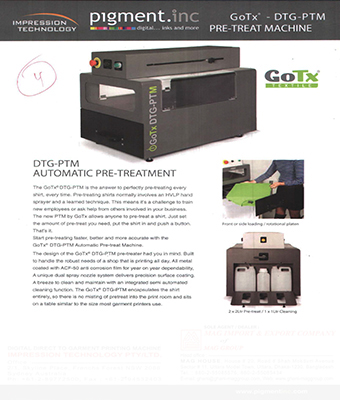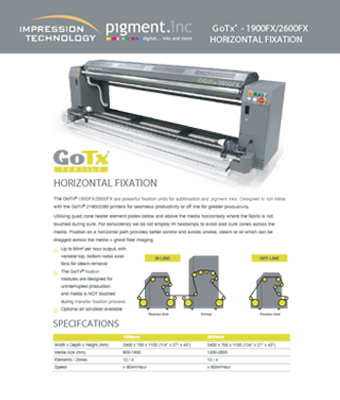- Products
- DTG Printing
DTG Printing
Company Profile
Impression Technology Pty Ltd. (ITPL) Sydney, Australia was founded in 1997 towards the activities of advanced digital engineering and chemistry. It strives to supply a truly unique digital print solution for textile and garments industries all over the world. The Impression Technology is one of the world strongest partners of producing a range of textile and garments printing machineries. THE ITPL INDUSTRIAL DTG Digital Printer has been an industry leader in direct to garment inkjet technologies for over the decade. Impression Technology now produces Inkjet Digital Direct to Garments (DTG) Printing Machine (pigment print on cotton, and blended fabrics), GoTx Direct to Fabric Printing Machine (print on cotton, blended and polyester fabric), GoTx Pre-treatment Machine and GoTx Horizontal Fixation Machine. ITPL also developed eco-friendly inkjet textile printing ink, pigment, re-active and sublimation ink and other pre-treatment chemicals suitable for their own machines.
With the success of over 8000 machine installations around the world, Impression Technology International Pty Ltd of Australia have lead the way in unique personalised and customized industrial digital engineering. These machines have already gained reputation with quality and services. ITPL’s products occupy a major market share in many of the European countries including Netherlands, Italy, Germany, France, Poland, England, Turkey and others. It has a strong presence in the USA, Asia and other regions. With Research and Development headquartered in Sydney, Australia and IPTL’s Digital DTG Printing Machine manufacturing plants are located in Singapore printing and DTG pre-treatment machine manufacturing plants are located in Malaysia. It has a dedicated global network of distributors and agents and service centres in the United Kingdom, the U.S.A and in Asia. The price of ITPL INDUSTRIAL DTG printing machines are very competitive and industry can set-up a full range printing required machines even than half of the price of the other available European machines with higher quality, productivity and post-installation services.
Company details
Website
http://www.impressiontechnology.com
Headquarters
Brookvale, NSW
Year founded
1997
Company type
Privately Held
Company size
11-50 employees
ITPL Digital-Direct to Garments (DTG) Printing Machine: A Revolution in Global Textile Printing Technology
In the last few years, textile technology has developed massively. Things that used to be impossible in textile are now easily doable without too much hassle. ITPL INDUSTRIAL DTG printer is the latest advancement in textile printing technology. It is one step forward to screen printing. ITPL INDUSTRIAL DTG printer is a new introduction in textile printing that allowed the printing companies to print designs from a computer, directly onto t-shirt, woven shirt, jacket, denim pant, denim shirt, 100% stitched cotton and blended fabrics for men, ladies, boys and girls. Any critical design printing is now possible without hassle which are mostly faced in screen printing. World largest companies with popular brands are now looking for more sophisticated environment friendly azo and other health hazard-free textile print product by high quality digital printing equipment instead of using traditional screen printing technology for readymade garments. There are so many positive aspects to take into account for the people who are still unfamiliar with the DTG printing machine.
Why is DTG Printing Machine required for Readymade Garment Industries of Bangladesh?
Bangladesh, the second largest garments manufacturing country of the world with more than 5000 industries (woven, knit, sweater, denim manufacturing industries and screen printing factories), is a very potential market for Direct to Garments and Direct to Fabrics printing machines in place of Screen Printing (manual and automatic) machines. To fulfil the increasing global requirement of quality printing products, a very small number of garment manufacturing industries of Bangladesh have switched over to DTG printing from screen printing. Introduction of ITPL INDUSTRIAL DTG printing machine parallel to their existing manual and screen printing machines for high density, flock, sticky rubber and oil-based printing, would definitely give more investment return with a range of value-added printing products. To meet the growing global market demands for fashion swimwear, t-shirt, garment and other textile products, the use of ITPL’s inks, fabric feeding and advanced print heads by the large manufacturing companies of Bangladesh will make their print production easy with a very affordable price.
The factory owners of Bangladesh should consider that the digital printing can print unlimited colour and recreate any design anyone can see virtually. This is an ultimate process that calls for artwork which needs to be handled by a computer and printed directly to the surface of the garment. It is much easier than any other method of garment printing. The machine simply works as printer what we use for printing a page from the computer. This is also a digital printer by which we can get printed t-shirt and other garments on larger scale with ink made for fabric. For same design, digital printer gives more smooth feeling, more accurate, and more quality product of any image than the screen printer. In this case, design processed and printed digitally brings the value-added quality output and highest returns from investment for Bangladeshi exporters.
1. The global textile industry is now trending toward low-volume customization because the market is demanding it. DTG printing can give a distinct advantage for Bangladeshi RMG exporters in fulfilling this need.
2. All the garment manufacturing industries of Bangladesh should add DTG printing unit for small to large-scale production seeing the need for quick-turn and high quality value-added products of the global companies.
3. Every industry should have multiple DTG printing units, with each machine printing 100 different custom orders per day. It is now considered as a necessary technology that can be used to satisfy customer demand.
4. High-quality DTG printing is a complex art form but relatively easy to accomplish.
5. With a very simple training, the industry people can get high-end and high-volume jobs done and assure good investment returns in a very shortest period of time.
6. The major problem with screen printing is that it is more time consuming and costly for creating unique designed multi-coloured t-shirt than DTG printing.
7. The screen printing process involves creating a screen and utilises it as a stencil for applying layers of ink on the printing surface. In this procedure, screen printing requires a long process to get various screens for distinct colours that are used in the design and merged to get the final look.
8. In DTG printer, one can get many colours together with highly cost-efficient process and can get easy and high-quality print on specified areas. It can print on a huge range of printable fabrics such as cotton, denim, stitched fabric, blended fabrics and others and the print can last longer than the screen print and give a very smooth felling if touches by hand.
Below are the reasons why textile and garment manufacturing industries should immediately switch over to Digital Direct to Garment and Fabric printing machines of Impression Technology Pty Ltd.:
1. The ITPL INDUSTRIAL DTG printing machine is environment and eco-friendly. It uses hassle free colour ink CMYK along with white and black for its inkjet printer heads for value added print of complicated designs with multi-coloured images.
2. For one ITPL INDUSTRIAL DTG printing machine, the electricity consumption is only 55 watts for DTG M-series, 200 watts for QM8 model as against of main motor of Screen printer which requires 10-15 KW for machine and 15 KW for flash curing of each of the printing head for each colour.
3. The cost of labour for ITPL INDUSTRIAL DTG printer is much lesser than the screen printing. For running 2 machines, it requires 2 operators and one helper.
4. The ITPL INDUSTRIAL DTG printing products give very smooth feeling when touches.
5. The ITPL INDUSTRIAL DTG print processing can be done within few minutes, even for a very complicated design with unlimited colours. It does not require any screen preparation, design film, mesh fabric, photo emulsion, frame, exposure, washing of frame, table gum, fixture and over and above no workers for doing all these jobs. Thus, the time requires for DTG printing is almost 10 times less than the screen printing.
6. ITPL INDUSTRIAL DTG printer can design any sample instantly, while for any designing the screen printing takes 5/6 hours, if it has multiple colours. The DTG machines are most suitable for printing on black and dark, white, light and medium colour fabrics.
7. The ITPL INDUSTRIAL DTG printer has no risk of contamination. More than 8000 DTG machines operating in different parts of the world hardly have any complain the performance.
8. The ITPL INDUSTRIAL DTG printing machine set-up requires less space. It does not require any steel or aluminium framing, installation of exhaust fan, and water supply. The machine does not give any noise and keep the floor clean.
9. The ITPL INDUSTRIAL DTG printing does not require mixing of colours like screen printing, which takes much time and has a risk of the fall of colour quality.
10. The ITPL INDUSTRIAL DTG printing does not have any ink, garment or fabric wastage as against of 15-20% chemical wastage and 10-15% drainage in screen printing.
11. The ITPL INDUSTRIAL DTG printing is suitable for printing on 100% cotton stitched ready t-shirt, fleece shirt, woven shirt, jeans denim pant, jacket, and stitch fabric cotton sweater for men, ladies, boys and girls and also on cut fabrics used for various purposes
The most important advantages of ITPL Digital Direct to Garment (DTG) printing include:
1. Cost-effective
The ITPL INDUSTRIAL DTG printer is easy to print various colours. It has changeable data and personalisation options. The DTG printing machine is ready to go for production instantly by just plugging in only. In DTG printer, there is no chance of bumping out of design.
2. Multiple Design Printing Option
The ITPL INDUSTRIAL DTG printer is good for multiple designs, and multi-coloured production in one time in one machine, while the multiple design printing by screen printer is very complicated, costly and time-consuming.
3. Modern Technology but easy production process
The ITPL INDUSTRIAL DTG printer does not require arduous and extensive preparation process like screen printing. The DTG has a lot more scope for flexibility because of lesser techniques required.
4. Value-added Production and High Profit
The price of ITPL INDUSTRIAL DTG printer is also now compatible to screen printer as the cost per unit remains the same but the market price for digital printing is higher than the screen-printed product as it can give more value-added products than the screen printer.
5. Detailed Design
The ITPL INDUSTRIAL DTG printer can manage detailed designs better than screen printing equipment when it comes to deciding between both the techniques. In DTG printer, printed images are sharper with more clarity. Even if any design has small touches or letters, DTG printer can give a full satisfaction of accurate printing.
6. Multi-Colour In one Time
The ITPL digital printer opts CMYK that mixes tones to mimic the right one, while the screen printing supplies can only make use of pure colour (often Pantone). The entire process of pouring every colour layer through the screens requires more time and efforts as well as make it more complicated to go from one colour to another colour. In ITPL digital printing on fabric, the image is directly transferred onto the material, and complete detail can be captured. In screen printing there is a risk of the degradation of quality of the image and in most cases, details may not get printed correctly.
7. Colour Concerns
However, when it comes to digital printing on fabric, there are numerous colours and no screens. So, instead of preparing all the screens before going for printing, in ITPL INDUSTRIAL DTG printing the only set up digital need is a pre-treatment of the black and dark garment/ t-shirt that offers the t-shirt/ garment a solid base and protects the digitally printed ink from smearing. The set up for digital is much easier and cost-efficient than the screen printer. For screen printing process, one has to set up a screen for every colour which indicates that the more complicated the design, the more screens the printer will need. This leads to the increase in manual labour which will automatically raise the cost. But for ITPL DTG printer, one can straight a way go for printing like printing a paper from the computer and can print all colours together.
8. Time Issues
Another important factor to take into consideration for ITPL INDUSTRIAL DTG printer is the total time consumed while using these techniques. If any factory wants to complete a work order within a short span of time, should go with digital printing, not the screen printing as the DTG method can handle a huge quantity in a short duration. As discussed earlier, the screen printing process is complicated. The preparation time will alone consume a significant amount of your time frame. In DTG, there is no setup cost for screens and not required much time.
9. Quality Issue
if anyone has vivid images to imprint, the ITPL INDUSTRIAL DTG printer is an ideal option as all the colours are present in the single image and the user does not need to separate screen for the same. Among all printing technologies, only ITPL INDUSTRIAL DTG printer can give the photo realistic quality print product.
10. Artwork
If there are lots of shades of various colours and fades, etc., or if the graphic is photo-realistic, company should go for digital printing instead of screen printing. The ITPL INDUSTRIAL DTG printer (direct to garment) is essentially an inkjet printer that prints on garments. The size capabilities and ink compositions vary, but generally they use water-based inks that work best on 100% cotton garments (or at least 50%), and, just like a computer printer, can capture stunning detail. One can use DTG printer for all of our photorealistic prints.
11. Durability
If cared for well, screen prints can be durable, but they can crack over time, particularly if the artwork contains large swaths of ink coverage. The soft-hand inks of DTG printer won't be prone to such cracking.
12. Cost-Benefit Analysis
Preparation for ITPL INDUSTRIAL DTG printing is much faster than the screen printer. A conservative estimate for screen printing 12 shirts — a five-colour job, from setup to breakdown — is four-plus hours. With ITPL DTG, 12 shirts can be prepared, printed and cured in about 30 minutes. With ITPL INDUSTRIAL DTG printer, one can confidently advertise low-minimum, custom, full-colour prints on light and dark garments.
13. Last but not the least
Finally, to conclude, digital printing on fabrics is the most popular approach today. In the past, there were rarely any digital printers, but now, most of the printing companies have a digital printer and make use of it for all single garment orders. The capability of designing outstanding graphics on computers is one of the skills highly in demand these days. However, before the advent of digital printing, computer generated drawings are still printed on apparels with the newest screen technology. It is no doubt that for attracting the world most popular brand producing companies, DTG is the best alternative to screen printing.
We must know that there are many ways to put a design on a t-shirt. Which way is “correct” depends on a variety of factors: budget, quantity, number of colours, material, print location, and much more. For this reason, the ITPL Direct-to-garment (DTG) printing is one of the newest technologies in the “apparel decoration industry”. The ITPL INDUSTRIAL DTG printing machine is pretty amazing with highly modified inkjet printer which uses ink made specifically for fibre and “spools” the t-shirt through the printer instead of a piece of paper.
Some Important features of our ITPL print head DX5 and DX7 DTG high performance printer:
1. The ITPL INDUSTRIAL DTG garment printer is the industry’s most cost effective, industrial two and six (M2 and M6) platen white ink capable direct to garment printer black, dark white and light colour garments and QM8 for white and light colour garments.
2. The ITPL INDUSTRIAL DTG printer with 3 different models is perfect for mid-to-high volume production.
3. Featuring superior quality output and Epson Print head reliability, the DTG printing also serves a variety of small-lot production jobs cost-effectively and with a wide range of colour options. Thanks to its unique ability to print multiple prints simultaneously, production can increase as a result of reduced cycle times and fast flexible downloading of new images.
4. The ITPL Inkjet garment printing is more economical, faster, and cleaner than traditional screen printing methods, plus it requires significantly less operating space and business start-up costs.
5. With ITPL INDUSTRIAL DTG advanced technology-based printers, designers can create one of a kind creations or mass production runs - regardless of the number of colours - without having to create film positives, stretching screens, and using chemicals to reclaim these screens.
6. There is virtually no limit to the number of colours you can print, and the colours remain crisp and vibrant even after repeated washes.
7. The ITPL INDUSTRIAL DTG printer has a proud heritage in direct to garment and textile decorating systems and the Print Head Epson DX5 with its CMYK white ink capabilities of 2 and 6 and Epson DX7 8 platens, and extra-large ink cartridges for white and light garments, is the most recent innovation for the Australian and other global market.
8. DTG ‘M’ series and QM8 series machines have the best quality operating features, lifelike imaging output and cutting-edge productivity tools and packs them into a high-tech garment printer.
9. With DTG ‘M’ series and QM8 series independently controlled 2, 6 and 8 platen and print-head modules – two, six and eight large and medium size, and 4, 12, and 16 pieces small (boys, girls and kids) size garments can be printed each image in each platen virtually simultaneously and independently. This ITPL INDUSTRIAL DTG machine is perfectly suitable for maximum productivity and potential for greater profitability because of its capacity to produce high resolution and multi-coloured design t-shirts and other readymade garments.
10. DTG M-series genuine CMYK and white ink and QM8 CMYK closed ink cartridge system provides superb output quality, and easy maintenance
11. The ITPL INDUSTRIAL DTG DX5 and DX7 genuine industrial-grade print-heads can provide top class printing speed.
12. Beside the Direct to Garment printing machines, the Direct to Textile Printing machine (GoTx 4190 and Gotx 2260) of the Impression Technology Pty Ltd is another innovation in textile technology. GoTx 4190/2260 Digital printing machine is designed for printing any image directly onto cotton and blended textile fabrics and is suitable for using water-based pigment ink and reactive ink. This machine is also suitable for using sublimation ink for polyester roll to roll fabrics. The ITPL has a fabric pre-treatment machine with both 1’9 and 2.6mtr width (model GoTx 1900/2600pt) for roll to roll fabric printing and a horizontal fixation machine with both 1.9 and 2.6mtr width (model GoTx 1900fx/2600fx) for roll to roll fabric printing.
DTG Printing Machine Set up
https://www.youtube.com/c/pigmentincprinters
https://www.youtube.com/watch?v=dnCAzkOSI2E&t=21s
https://www.youtube.com/watch?v=RmdBjMTwonY
https://www.youtube.com/watch?v=ceuIGCY_fBk
https://www.youtube.com/watch?v=HNe8LuECzUQ
https://www.youtube.com/watch?v=eaK8oa30P6Q
https://www.youtube.com/watch?v=6AU97QkLBFI
https://www.youtube.com/watch?v=yVa9-0nMG5Y
https://www.youtube.com/watch?v=maU4-0Sg_G0

